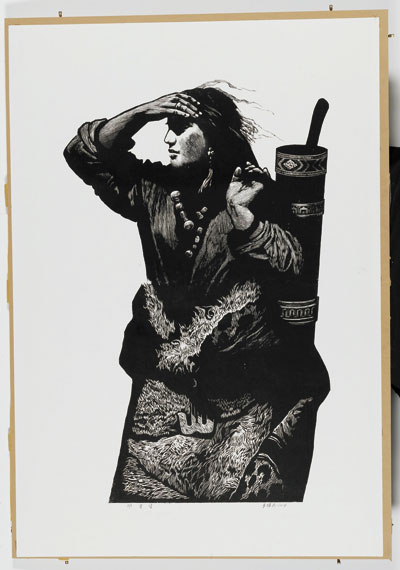
Wang Haiying
why.art@163.com
TO enrich the brilliant history of printmaking in China, where printmaking originated, the printmaking section of the 12th National Exhibition of Fine Arts China 2014, is now open at the Guangdong Museum of Art in Guangzhou until Oct. 12 with 349 pieces of excellent prints that demonstrate this unique and fascinating medium and how it has developed over time.
Consisting of 13 sections of fine arts in 13 cities, the major national exhibition is jointly organized by the Ministry of Culture, the China Federation of Literary and Art Circles and the China Artists Association to celebrate the 65th anniversary of the founding of the People’s Republic of China.
Created by contemporary artists, the printmaking works of various styles with new techniques in this exhibition mainly reflect the changes of contemporary society and express colorful dreams and wishes for better lives and a prosperous country.
Along with the development of science and technology, the life of the Chinese has greatly improved thanks to all kinds of modern facilities. Many prints in this exhibition reflect various aspects of society’s development.
Showing people paying rapt attention to their smartphones, “Life on Light-rail” by Chongqing artist Shu Sha adopts parallel compositions to depict many kinds of people on the train. Its concise and expressionist figures create a kind of humorous effect.
In terms of transportation, “Night Scene” by Jiangsu artist Yu Wufeng uses smooth and straight lines to stress the speed of high-speed trains. The amazingly fast development of science and technology attracted many artists who enjoy dreaming of fancy lives far away from reality, even on the moon. Wearing beautiful butterfly wings, the people in “Flying to the Moon” by Guangdong artist Zheng Feng are either gathering in a circle inside luminous big flowers or flying among fairy birds. This mysterious illusion resembles scenes from science fiction movies.
In recent decades, life with high-tech facilities is only part of a dream. Human beings are in urgent need of a healthy ecological environment, one in which trees or woods should occupy most of the living space in order to ensure the normal state and cleanliness of the air and water. A large number of artists in the printmaking exhibition explore different aspects of ecological issues, such as air, water and plants.
The grand ancient building in “Scenery: Taihe Palace,” by Beijing artist Zhou Jirong, is blurred due to opaque air. Every subway train passenger, including a dog and a doll-bear, in “Series of Fantasy of Subway Line 8” by Guangdong artist Qin Yiting is wearing a protective mask.
“Wind Moaning in the Moonlight” by Guangdong artist Gu Yiming shows a leafless tree trunk standing alone on the vast grassland with a couple of withered leaves scattered in the air. Since many crowded skyscrapers have occupied the great mountain in the background, the vast grassland is submerged under the sea.
In spite of all this imbalance, however, all of the artists hope that the ecological environment will become green again and that the climate will regain its normal state. Presenting a sharp contrast of yellow ( representing “light”) and blue ( representing “shade”), “Habitable Scenery” by Shaanxi artist Zhou Zhongming illustrates an ideal urban Beijing, where the brilliant sunlight beautifies both the ancient and modern buildings and a colorful rainbow decorates the blue sky.
Many artists in the printmaking exhibition show a great interest in the lives of ethnic minorities or people not living in major cities. One of the representative artists is Li Huanmin from Sichuan Province (born in 1930), one of the most outstanding artists in the history of Chinese printmaking, who has created many extraordinary prints representing the life of the Tibetan people. His large black-and-white woodcutting “Keep Waiting” made in 2014 is a brilliant piece of work. Holding a cylinder for making butter-tea on her shoulder, a young Tibetan woman is looking at something far away on the grassland with a lifted hand shading her eyes against strong sunlight on the plateau. The vigorous and meticulous carvings and every detail in the print excellently represent the graceful woman’s strong and determined nature.
Belonging to the Han nationality, the ornate costumes of the Hui’an women from Fujian Province are well-known. Assured by the peaceful clouds in the sky, courageous Hui’an women on a fishing boat pray for success before going out to sea in “Auspicious Clouds” by Song Guangzhi, one of the preeminent Guangdong artists who has created a series of excellent prints portraying Hui’an women. Many artists also found ethnic minority architecture fascinating. The straight hatchings and square forms in “Ancient Stockaded Village of Qiang Nationality” by Sichuan artist Sheng Haibo well convey the serenity and unique beauty of the ancient buildings.
The artists featured in this national exhibition express their colorful dreams by employing various techniques inherited from the profound and brilliant tradition of printmaking in China, a country with a printmaking history of more than 1,100 years.
(Author Wang Haiying is a researcher for the Guangdong Museum of Art )
Venue: Halls 1-12 (except Hall 7), Guangdong Museum of Art,
38 Yanyu Road, Ersha Island, Guangzhou
Date: Through Oct. 12
Time: 9 a.m.-5 p.m., Tuesday-Sunday
|

